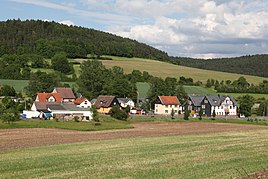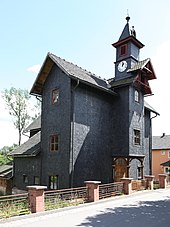Rare village
|
Rare village
Community Frankenblick
Coordinates: 50 ° 23 ′ 3 ″ N , 11 ° 3 ′ 36 ″ E
|
|
|---|---|
| Height : | 390 (390-400) m |
| Residents : | 330 (2008) |
| Incorporation : | June 30, 1994 |
| Incorporated into: | Effelder-Rauenstein |
| Postal code : | 96528 |
| Area code : | 036766 |
|
View of the place
|
|
Seltendorf is a village in the municipality of Frankenblick in the district of Sonneberg (Thuringia). Around 330 people live in Seltendorf and the Welchendorf settlement a few hundred meters to the northwest (as of 2008).
geography
Seltendorf is located on the southern edge of the Thuringian Slate Mountains at an altitude of almost 400 meters above sea level. M. (train station). The place is traversed by the small river Retschenbach , which rises above the Zinselhöhle near Meschenbach , crosses the Zinselhöhle and flows into the Effelder (river) below Seltendorf at the Bätzmühle .
Seltendorf lies in a depression and is surrounded by the mountains Langer Berg, Kurzer Berg, Hohe Leite and Tennich. All older houses stand along the former local road on the banks of the Retschenbach, which crosses the town in a north-south direction. Houses built after 1850 are mostly located on Neue Meininger Chaussee, whose course in east-west direction now also characterizes the town as federal road 89 .
The location of Seltendorf is geologically interesting in a zone in which shell limestone in the north and red sandstone in the south alternate immediately and seamlessly. This rock boundary runs roughly on the route of the federal road in the bottom of the depression.
history
The place was first mentioned in 1232 as Selckendorf in a document. In the course of time the spelling changed to Seltendorf. The place was always parish after Effelder. The inhabitants of Seltendorf, provided they belong to a Christian church, have been almost exclusively Protestant since the Reformation.
A good description of the place can be found in the topography of the parish Effelder by Pastor T. Heim from the beginning of the 19th century. Heim writes of 15 farms and two mills on the Retschenbach, as well as a tree nursery in the middle of the village. According to Heim, hops were grown on the southern slope of the Hohen Leite , otherwise the grain fields went up to the peaks of the Long and Short Mountains. These mountains are now forested far down into the valley. The meadows on the Retschenbach are mostly acidic and wet. This is still the case today. Interesting is the mention of a brick factory between Blatterndorf and Seltendorf, which, however, no longer existed in Heim's time.
Until its demolition in 2007, the oldest building in Seltendorf was the Zehntstadel, a barn on the road towards Effelder. The now oldest buildings are likely to be the former farmhouses in what is now Döhlauer Straße. They were built in the 18th century, e.g. T. also earlier.
There has been an inn in Seltendorf since around 1830. Around 1900 a new one with an annex was built, but the bar has now ceased.
The mills mentioned by Pastor Heim are still there, but the buildings have been rebuilt several times and the grinders are no longer in operation. It was a question of Märbelmühlen . No flour was ground in these, but rather small pieces of stone ground into round balls, so-called marbles ( marbles ). These were u. a. used as a children's toy. The fairytale industry developed into a not insignificant branch of industry in southern Thuringia in the 18th century.
At the beginning of the 20th century Welchendorf belonged to Seltendorf for a short time, but was independent again from 1923. After the Second World War, Welchendorf was incorporated again.
On July 1, 1950, the previously independent municipality of Döhlau, located in the southern Effeldertal, was incorporated. Döhlau was isolated from the municipal parts of Seltendorf and Welchendorf from 1972 to 1989 by a checkpoint and barrier because of its location in the restricted area .
Most of the inhabitants of Seltendorf were employed in agriculture until the 1960s.
In Seltendorf at the end of the village in the direction of Döhlau a school was built around 1880, in which the children from Seltendorf, Welchendorf and Döhlau were enrolled and taught until around 1980. The building with the bell tower and clock is owned by the municipality of Effelder-Rauenstein.
From 1994 Seltendorf belonged to the municipality of Effelder-Rauenstein . The incorporation was controversial in the Seltendorfer municipal council. The first mayor to be freely elected again after the end of SED rule in 1990, Horst Eckstein from Döhlau, was also the last. On January 1, 2012, Seltendorf became part of the municipality of Frankenblick as part of the merger of the municipalities of Effelder-Rauenstein and Mengersgereuth-Hammern .
Culture and sights
Seltendorf has retained a largely village character to this day. The ground monument is the Marterstein in Welchendorf, which was erected in the tradition of a Franconian wayside shrine in the pre-Reformation period on the way to Roth.
The largest club is SV 1960 Seltendorf, a football club that has played in the district league of the Sonneberg district since 2003. A march through the Seltendorfer footballers caused a stir in the 1990s, when the promotion succeeded three times in a row from the 2nd district class to the district league. The SV 1960 operates a club shop on Sonneberger Strasse and is also the leaseholder of the sports field, which has been expanded.
There is also a volunteer fire brigade in Seltendorf . The Seltendorf men's choir is also one of the few men's choirs that have remained in the region. Founded in Welchendorf in 1889, the choir has 25 singers from Seltendorf and the surrounding villages (as of 2008).
The Seltendorf riding and driving club, founded around 1980, has now pitched its tents in the Döhlau district.
The highlight of community life is the annual church fair (Kärwa), which takes place as a plank church fair on the third weekend in July.
Economy and Infrastructure
Seltendorf has a stop on the Eisfeld – Sonneberg railway line . The village is also crossed by the federal road 89 . There is a bus connection to Sonneberg and Schalkau .
In addition to a few handicraft businesses, there is a larger agricultural cooperative with dairy farming and arable farming as well as a metal industry company on Seltendorfer Flur. Many working people commute to work in the neighboring larger cities.
There is a kindergarten in Seltendorf, which is sponsored by the Sonneberger Diakonie. The school children are taught in Rauenstein, Schalkau or Sonneberg.
Sons and daughters
- Sabine Bruhns (* 1951) - pop singer
- Kristin Bauersachs (* 1985) - musical interpreter
dialect
Itzgründisch , a Main Franconian dialect, is spoken in Seltendorf .

